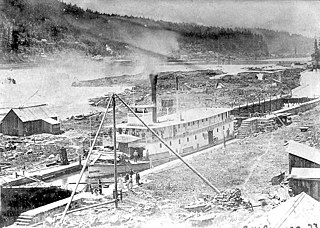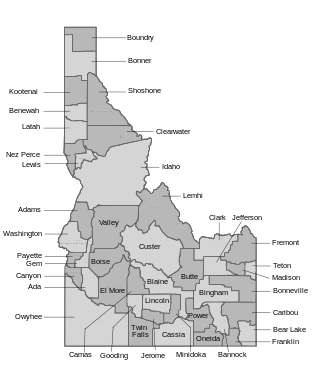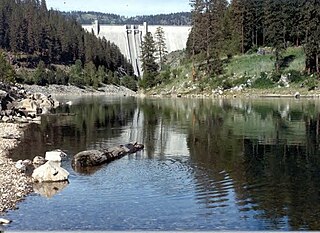Tributaries and sub-tributaries are hierarchically listed in order from the mouth of the Columbia River upstream. Major dams and reservoir lakes are also noted.
Contents
- Willamette River system
- Snake River system
- Yakima River system
- Pend Oreille River system
- Kootenay River system
- See also
- References

List of major tributaries
The main river and tributaries are (sorted in order from the mouth heading upstream):
| Left tributary | Right tributary | Length (km) | Basin size (km2) | Average discharge (m3/s) |
|---|---|---|---|---|
| Lower Columbia Mouth to Bonneville Dam | ||||
| Youngs | 43 | 257.6 | 14.7 | |
| Grays | 48 | 320 | 15.9 | |
| Elochoman | 24 | 490 | 10.8 | |
| Clatskanie | 40 | 269.2 | 10.6 | |
| Cowlitz | 169 | 6,698 | 286.6 | |
| Kalama | 72 | 530 | 34.5 | |
| Lewis | 153 | 2,709 | 173.4 | |
| Lake | 18 | 260 | ||
| Willamette | 301 | 28,949 | 1,098.7 | |
| Washougal | 53 | 550 | 24.7 | |
| Sandy | 92 | 1,316 | 65 | |
| Middle Columbia | ||||
| Wind | 48 | 580 | 34.2 | |
| Little White Salmon | 31 | 350 | ||
| White Salmon | 71.3 | 1,000 | 30.4 | |
| Hood | 40 | 720 | 27.6 | |
| Klickitat | 154.3 | 3,496 | 44.5 | |
| Fifteenmile Creek | 87 | 970 | 5.6 | |
| Deschutes | 406 | 27,549.6 | 215.7 | |
| John Day | 457 | 20,521.3 | 80.4 | |
| Willow Creek | 127 | 2,300 | 0.9 | |
| Umatilla | 143 | 6,345 | 14 | |
| Upper Columbia | ||||
| Walla Walla | 98 | 4,553 | 34.3 | |
| Snake | 1,735 | 260,938.7 | 1,755.6 | |
| Yakima | 344 | 15,930.4 | 100.3 | |
| Crab Creek | 262 | 13,200 | 40.4 | |
| Wenatchee | 85 | 3,473.1 | 103.7 | |
| Entiat | 92 | 1,210 | 20.2 | |
| Chelan | 6.6 | 2,390 | 57.8 | |
| Methow | 129 | 4,727 | 44.4 | |
| Okanogan | 185 | 21,385.7 | 99 | |
| Nespelem | 580.8 | 2.5 | ||
| Sanpoil | 95 | 2,540 | 11.4 | |
| Spokane | 179 | 17,353.4 | 228.6 | |
| Colville | 97 | 2,646.8 | 16.4 | |
| Kettle | 282 | 10,877 | 82.3 | |
| Pend Oreille | 771 | 67,055.5 | 850.2 | |
| Kootenay | 780 | 50,298 | 868 | |
| Whatshan | 581.4 | 12 | ||
| Mosquito Creek | 435 | 10.2 | ||
| Kuskanax Creek | 350.9 | 10.6 | ||
| Halfway | 447.4 | 14.2 | ||
| Incomappleux | 1,020 | 55.8 | ||
| Akolkolex | 388.7 | 16.5 | ||
| Illecillewaet | 62 | 1,213.3 | 61.4 | |
| Jordan | 345.6 | 11.1 | ||
| Downie Creek | 655.8 | 27.9 | ||
| Goldstream | 954.4 | 39.5 | ||
| Big Mouth Creek | 591.2 | 22.9 | ||
| Canoe | 712.6 | 15.2 | ||
| Wood | 841.7 | 18.1 | ||
| Cummins | 262.6 | 8.5 | ||
| Kinbasket | 261.3 | 7.6 | ||
| Windy | 252.3 | 10.2 | ||
| Sullivan | 632.5 | 18.9 | ||
| Bush | 1,100.1 | 25.5 | ||
| Gold | 566.4 | 27.9 | ||
| Beaver | 1,163 | 54.3 | ||
| Bluewater | 392.5 | 12.5 | ||
| Waitabit Creek | 352.2 | 9.6 | ||
| Blaeberry | 60 | 745.6 | 17.8 | |
| Kicking Horse | 1,815.4 | 40.9 | ||
| Canyon Creek | 161.7 | 4.9 | ||
| Spillimacheen | 118 | 1,456.2 | 38 | |
| Bugaboo Creek | 368.4 | 7.3 | ||
| Forster Creek | 592.4 | 8.8 | ||
| Horsethief Creek | 630.5 | 10 | ||
| Toby Creek | 673.5 | 9 | ||
| Dutch Creek | 676.5 | 7.9 | ||
- Wallacut River (Washington)
- Chinook River (Washington)
- Alder Creek (Oregon)
- Tansy Creek (Oregon)
- Skipanon River (Oregon)
- Youngs River (Oregon)
- Lewis and Clark River (Oregon)
- Wallooskee River (Oregon)
- Klaskanine River (Oregon)
- Frank Born Creek (Washington)
- Sisson Creek (Washington)
- Deep River (Washington)
- Grays River (Washington)
- Crooked Creek (Washington)
- Harlow's Creek (Washington): Formerly "Jim Crow Creek"
- Elochoman River (Washington)
- John Day River (Oregon)
- Eskeline Creek (Oregon)
- Hillcrest Creek (Oregon)
- Big Creek (Oregon)
- Little Creek (Oregon)
- Gnat Creek (Oregon)
- Kelly Creek (Oregon)
- Spear Creek (Oregon)
- Hunt Creek (Oregon)
- Driscoll Slough (Oregon)
- Westport Slough (Oregon)
- Plympton Creek (Oregon)
- West Creek (Oregon)
- Ross Creek (Oregon)
- Olsen Creek (Oregon)
- Eilertsen Creek (Oregon)
- OK Creek (Oregon)
- Favorite Creek (Oregon)
- Tandy Creek (Oregon)
- Graham Creek (Oregon)
- Clatskanie River (Oregon)
- Fall Creek (Oregon)
- Merril Creek (Oregon)
- Perkins Creek (Oregon)
- Coal Creek Slough (Washington)
- Cougar Creek (Washington)
- Abe Creek (Washington)
- Mill Creek (Washington)
- Abernathy Creek (Washington)
- Germany Creek (Washington)
- Coal Creek Slough (Washington)
- Cowlitz River (Washington)
- Coweeman River (Washington)
- Toutle River (Washington)
- Mayfield Dam and Lake Mayfield (Washington)
- Tilton River (Washington)
- Mossyrock Dam and Riffe Lake (Washington)
- Cowlitz Falls Dam and Lake Scanewa (Washington)
- Cispus River (Washington)
- Muddy Fork (Washington)
- Clear Fork (Washington)
- Ohanapecosh River (Washington)
- Kalama River (Washington)
- Lewis River (Washington)
- East Fork Lewis River (Washington)
- Merwin Dam and Lake Merwin (Washington)
- Yale Dam and Yale Lake (Washington)
- Swift Dam and Swift Reservoir (Washington)
- Lake River (Washington)
- Buckmire Slough (Washington)
- Salmon Creek (Washington)
- Whipple Creek (Washington)
- Flume Creek (Washington)
- Bachelor Island Slough (Washington)
- Willamette River (Oregon; see below for sub-tributaries)
- Washougal River (Washington)
- Sandy River (Oregon)
- Bull Run River
- Salmon River (Oregon)
- Zigzag River (Oregon)
- Gibbons Creek (Washington)
- Crusher Creek (Oregon)
- Rainbow Creek (Oregon)
- Lawton Creek (Washington)
- Latourell Creek (Oregon)
- Young Creek (Oregon)
- Bridal Veil Creek (Oregon)
- Coopey Creek (Oregon)
- Dalton Creek (Oregon)
- Mist Creek (Oregon)
- Wahkeena Creek (Oregon)
- Multnomah Creek (Oregon)
- Good Bear Creek (Washington)
- Archer Creek (Washington)
- Indian Mary Creek (Washington)
- Oneonta Creek (Oregon)
- Horsetail Creek (Oregon)
- Duncan Creek (Washington)
- Tumalt Creek (Oregon)
- Woodard Creek (Washington)
- Hardy Creek (Washington)
- McCord Creek (Oregon)
- Hamilton Creek (Washington)
- Metasequoia Creek (Oregon)
- Moffett Creek (Oregon)
- Tanner Creek (Oregon)
- Bonneville Dam and Lake Bonneville (Washington, Oregon)
- Eagle Creek (Oregon)
- Sorenson Creek
- Tish Creek
- Opal Creek (Oregon)
- Ruckel Creek (Oregon)
- Rudolph Creek (Oregon)
- Dry Creek (Oregon)
- Rock Creek (Washington)
- Kanaka Creek (Washington)
- Herman Creek (Oregon)
- Nelson Creek (Washington)
- Carson Creek (Washington)
- Grays Creek (Oregon)
- Wind River (Washington)
- Gorton Creek (Oregon)
- Harphan Creek (Oregon)
- Summit Creek (Oregon)
- Collins Creek (Washington)
- Lindsey Creek (Oregon)
- Wonder Creek (Oregon)
- Warren Creek (Oregon)
- Cabin Creek (Oregon)
- Starvation Creek (Oregon)
- Dog Creek (Washington)
- Viento Creek (Oregon)
- Perham Creek (Oregon)
- Little White Salmon River (Washington)
- Phelps Creek (Oregon)
- White Salmon River (Washington)
- Henderson Creek (Oregon)
- Hood River (Oregon)
- Dry Creek (Washington)
- Jewett Creek (Washington)
- Mosier Creek (Oregon)
- Catherine Creek (Washington)
- Major Creek (Washington)
- Rowena Creek (Oregon)
- Klickitat River (Washington)
- Gooseberry Creek (Oregon)
- Chenoweth Creek (Oregon)
- Mill Creek (Oregon)
- Fifteenmile Creek (Oregon)
- The Dalles Dam and Lake Celilo (Washington, Oregon)
- Deschutes River (Oregon)
- White River (Oregon)
- Warm Springs River (Oregon)
- Round Butte Dam and Lake Billy Chinook (Oregon)
- Crooked River (Oregon)
- Arthur R. Bowman Dam and Prineville Reservoir (Oregon)
- Metolius River (Oregon)
- Whychus Creek (Oregon)
- Tumalo Creek (Oregon)
- Spring River (Oregon)
- Little Deschutes River (Oregon)
- Fall River (Oregon)
- Cultus River (Oregon)
- Snow Creek (Oregon)
- John Day Dam and Lake Umatilla (Washington, Oregon)
- John Day River (Oregon)
- Willow Creek (Oregon)
- Umatilla River (Oregon)
- McNary Dam and Lake Wallula (Washington, Oregon)
- Walla Walla River (Washington, Oregon)
- Touchet River (Washington)
- Snake River (Washington, Oregon, Idaho, Wyoming; see below for sub-tributaries)
- Yakima River (Washington; see below for sub-tributaries)
- Priest Rapids Dam (Washington) and Priest Rapids Lake (Washington)
- Crab Creek (Washington)
- Wanapum Dam (Washington) and Lake Wanapum (Washington)
- Rock Island Dam (Washington) and Rock Island Pool (Washington)
- Wenatchee River (Washington)
- Rocky Reach Dam and Lake Entiat (Washington)
- Entiat River (Washington)
- Mad River (Washington)
- Chelan River (and Lake Chelan) (Washington)
- Stehekin River (Washington)
- Wells Dam and Lake Pateros (Washington)
- Methow River (Washington)
- Twisp River (Washington)
- Okanogan River (Washington, British Columbia)
- Similkameen River (British Columbia, Washington)
- Tulameen River (British Columbia)
- Pasayten River (British Columbia, Washington)
- Okanagan Lake (British Columbia)
- Similkameen River (British Columbia, Washington)
- Chief Joseph Dam and Rufus Woods Lake (Washington)
- Nespelem River (Washington)
- Grand Coulee Dam and Franklin D. Roosevelt Lake (Washington)
- Sanpoil River (Washington)
- Spokane River (Washington, Idaho)
- Spokane Falls (Washington)
- Little Spokane River (Washington)
- Latah Creek (Washington and Idaho)
- Lake Coeur d'Alene (Idaho)
- Coeur d'Alene River (Idaho)
- Saint Joe River (Idaho)
- Saint Maries River (Idaho)
- Colville River (Washington)
- Martin Creek (Washington)
- South Fork Roper Creek (Washington)
- Sherman Creek (Washington)
- Nancy Creek (Washington)
- Katy Creek (Washington)
- Kettle River (Washington, British Columbia)
- Granby River (British Columbia)
- West Kettle River (British Columbia)
- Pend Oreille River (British Columbia, Washington, Idaho; see below for sub-tributaries)
- Kootenay River (British Columbia, Idaho, Montana; see below for sub-tributaries)
- Hugh Keenleyside Dam and Arrow Lakes (British Columbia)
- Whatshan River (British Columbia)
- Whatshan Dam (British Columbia)
- Beaton Creek (British Columbia)
- Incomappleux River (British Columbia)
- Illecillewaet River (British Columbia)
- Revelstoke Dam and Revelstoke Lake (British Columbia)
- Goldstream River (British Columbia)
- Mica Dam and Kinbasket Lake (British Columbia)
- Canoe River (British Columbia)
- Wood River (British Columbia)
- Bush River (British Columbia)
- Valenciennes River (British Columbia)
- Blaeberry River (British Columbia)
- Beaver River (British Columbia)
- Kicking Horse River (British Columbia)
- Yoho River (British Columbia)
- Spillimacheen River (British Columbia)
- Templeton River
- Columbia Lake (British Columbia)













